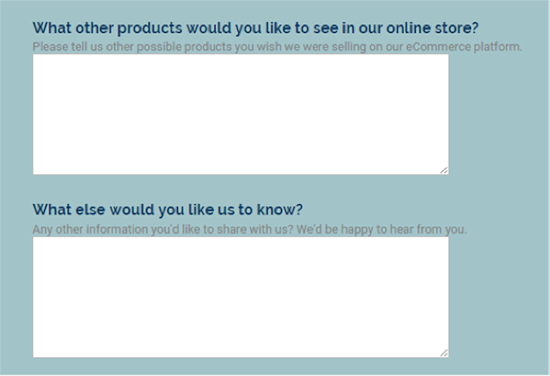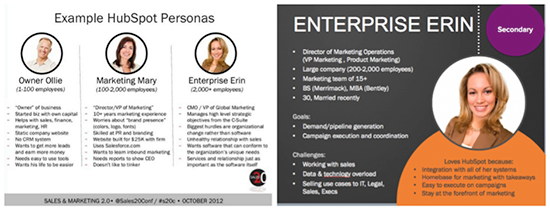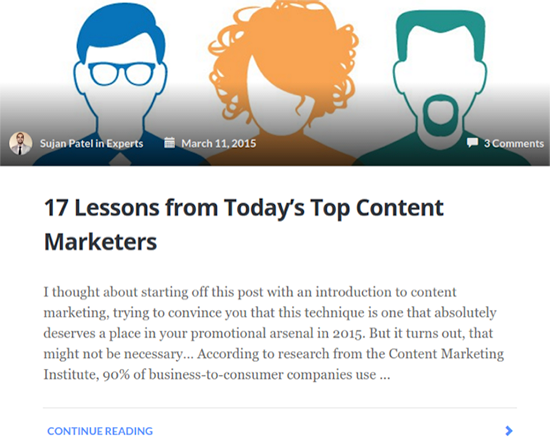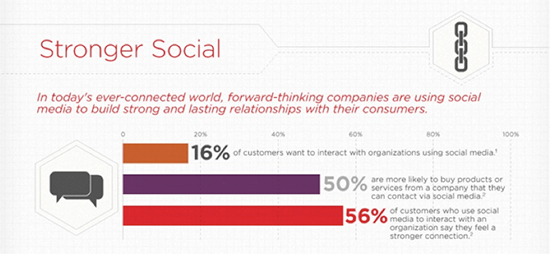CMI’s 2016 Benchmarks, Budgets, and Trends Survey found that 88% of B2B companies are using content marketing.
Why? Because it works.

Content improves customer and brand relations. It can influence purchasing decisions. It can rank in the search results and drive qualified traffic to your site. It can encourage people to link back to your site and improve its overall long-term health and visibility.
Not convinced?
Let’s take a look at some stats to back this up.
- 82% of consumers feel more positive about a company after reading custom content, and 90% find custom content useful. (CMI)
- Annual growth in unique site traffic is 7.8x higher for content marketing leaders compared to followers (19.7% vs 2.5%). (Kapost)
- Number of backlinks is the fourth most important factor of top-ranking websites, with number of new backlinks in the top 15 important factors. (Search Metrics)
Any company that wants to be on a level playing field needs to be investing in content. This is all the more true for startups that have a brand and customer base to build.
The only difference is how you should be using content marketing.
-
“If you are a startup, content marketing can be the way you differentiate your business and engender trust with your customers and prospects. It’s something you can use to generate awareness in your brand all the way to helping customers evangelize your business.”
— Michele Linn, VP of content at Content Marketing Institute, writing for SEO Hacker
A limited budget and the fact that you’re trying to build a brand from the ground up means your content strategy is probably going to look pretty different from that of a large enterprise, or even an established SMB.
Stick with me and you’ll find out just how a startup should be using content marketing for maximum effect.
Deciding How and Where to Spend Your Budget
Deciding how much cash to invest in content marketing, and where you’re going to spend it, could be one of the toughest budgeting decisions you and your company make.
It could also be one of the most important.
In theory, spending more money should get you better results, but only if you spend that money wisely. You could have $100,000 a month to spend on content, but if you’re spending it on the wrong things, it’s probably going to waste.
So what should you spend?
Let’s assume that as a startup you only have a small pot of cash to play with. You probably want to know much should you allocate to content, right?
Well, I’m going to tell you.
You should allocate…
Whatever you can afford.
That might sound like I’m dodging the question, but the fact is, I can’t tell you what to spend.
You should spend what you can comfortably afford, without putting your business at risk.
When it comes to where you should spend your money, you’re going to want maximum rewards for minimum investment. You’re also going to want to place safe bets.
Big corporations can afford to gamble thousands of dollars on a content piece that may or may not work. You’re going to need to play your cards a little closer to your chest.
You’ll learn more about what type of content drives the biggest rewards for startups very shortly, but first, we’re going to talk about something that will help you in your quest to create effective yet affordable content…
Knowing Your Audience
One of the shortcomings of startup life is the lack of customer data you have to draw from. An effective content strategy is guided in part by customer pain points and the questions they ask.
But what do you do if you don’t have access to this information?
You start asking them.
It doesn’t matter if it’s your first customer or your 50 thousandth — the sooner you start asking customers for feedback, the sooner you can start using their answers to enhance your content strategy (and make informed improvements to other parts of your business, too).
So how do you get this feedback?
Customer surveys are the first thing that come to mind. Your customer receives a form, answers a few questions, and BAM! You have your feedback.
- But there are lots of different ways to execute a customer survey.
- Should the survey be long or short?
- Should you ask closed or open-ended questions?
- Which customers should receive the survey and when? While they’re browsing the site? Should it appear after a completed purchase? Should it be sent in an email shortly after making a purchase (to give the customer time to try the product out?
The answer here is: it depends on what you’re trying to achieve.
As a general rule, however:
You’ll get more responses with shorter surveys, and you’ll get more detailed feedback by asking open rather than closed-ended questions.
If we’re to assume that you’re executing this survey for the purpose of improving your content targeting, you’ll probably want to ask questions like…
What brought you to the site today?

And you should avoid closed-ended questions like…
Did you find everything you were looking for?
Would you like to see more of x?

To summarize, asking just one or two open-ended questions will generally garner the best results. You’ll force customers to think for themselves and prevent customers from being deterred by intimidating contact forms.
Another excellent means of getting customer feedback is to ask them personally. Send them an email. Call them up. Or, if they’re local, take them out to lunch.
-
“Invite them to lunch and tell them you’re looking to completely understand how your business helps solve their problem. You will get more value from this one-hour lunch then you will from hundreds of customer surveys.”
— Lars Lofgren, Director of Growth at I Will Teach You to Be Rich and former Director of Growth at Kissmetrics, for Kissmetrics
This works very well — particularly for startups with only a few customers to focus on.
Not only does it get you far more detailed information than you’ll ever get from a survey, it helps build a closer relationship between you and the customer (meaning they’re likely to stick around longer).
To exploit the data you collect through surveys to the max, use it to build a detailed buyer persona.
A buyer persona is a semi-fictional “character” you create that embodies one or more of your standard customers.

I wrote a post last year in which I listed 150 questions you can ask to help build a buyer persona. HubSpot also has an excellent buyer persona template that you can download for free.
Keyword research
Keyword research is useful for much more than keyword targeting — it can tell you a lot about your audience, too, long before you’ve had a chance to start gathering first-hand data yourself.
Take Answer the Public, for instance. You just enter a topic into the search box, press “Get Questions,” and the tool scrapes Google’s autosuggest to formulate a list of questions that are being searched for on that topic.

Another ever-popular tool that functions in a similar way (by scraping Google autosuggest) is Ubersuggest.
Again, you simply enter a keyword of interest and hit “suggest.” The tool will then get to work tracking down all the keywords Google could suggest to searchers based on permutations of your initial search.

I also like FAQFox, which isn’t strictly a keyword research tool, but can be used for the same purpose.
It essentially scrapes websites for a keyword or phrase of your choice in order to find questions and topics of discussion in those areas.
All you need to do is enter the sites you want to search and the phrase you want to search them for, and press “Start Searching.”

Of course, there’s only so much you can learn about your customers when you don’t actually have very many of them.
At some point, you’re just going to have to bite the bullet and start creating content.
What to Create
Once you know who you’re targeting and the type of questions they’re asking, the next step is to decide what content you’re going to create.
As a startup, your priorities are probably going to differ from those of a more established company.
Your initial goals are likely to revolve around building general awareness of your brand. You’ll probably want to push yourself and your brand as a trustworthy authority in your industry, too.
You’re also going to want to maximize the return on your potentially quite small investment.
Content for your blog
I helped get Content Marketer off the ground in large part simply by using the blog. I wanted to educate our audience and potential customers. This was the first-ever post I published there.

My thinking was that the more our audience understood about content marketing, the greater their need would be for the tool.
More than a year later, the blog is still a huge part of Content Marketer. Although I only contribute myself every so often, I try to ensure fresh content appears a few times a month, at least.
Educational articles published on your own blog are cost-effective and offer short and long-term rewards.
The key to making it work is to write genuinely useful content that helps others while simultaneously showcasing your own expertise.
Content for links
Once you’ve succeeded in building brand awareness, you’re probably going to want to create content that has the potential to be picked up and shared by other publications. When they do this, they will generally credit you by linking back to your site — this is important for building your website’s domain authority and helping to boost its visibility in the search results.
Infographics are probably the most commonly-used tool for this purpose.
Infographics display information or data in an attractive format that’s easier to digest (and share) than written content. The best ones tell a story with that information.
Best of all, they don’t have to cost a lot. Wrap an interesting and unique story in simple but attractive packaging, and you should be onto a winner.
Buffer’s Sandrine Sahakians created this, for free, in just 15 minutes…

Okay, so it’s a long way from the standard you should be aiming for, but it’s a great example of how easy it is to create this sort of content if you have the right tools.
You can find out more about making infographics fast and for free in Sandrine’s post.
Sales funnel content
Once you’ve got a link-focused content strategy underway, it would be wise to look at creating content that targets visitors at each stage of the sales funnel.
The “sales funnel” represents the process a customer goes through before deciding to make a purchase. Creating content for the sales funnel entails targeting queries customers are likely to ask at each stage of that process.
How many stages there are in a sales funnel and what those stages are will differ depending on who you ask. However, for the purpose of this article I’m going to talk about a four-stage funnel: awareness, consideration, conversion, and advocacy.

At the awareness stage (also known as the “top of the funnel”) your audience has realized they have a need and that they’re going to have to start researching the best way to fulfill it.
Content at this stage would probably target generic, head search terms such as:
- “Project management”
- “Time management”
- “Search engine optimization”
The sort of topics you might look at covering could be…
- What is Project Management?
- 20 Quick Tips for Better Time Management
- Search Engine Optimization: Elementary Essentials
The idea here is not to push your product onto customers, but to gently guide those who could benefit from it towards it, via content that solves their pain points.
At the consideration stage, the customer is pretty sure they know what they’re looking for; they’re just not yet sure who they’re going to buy from.
Consideration stage content would target phrases like:
- “The best new project management tools”
- “Tools to help time management”
- “SEO agencies in Seattle”
This might mean creating content that introduces the customer to your product, without forcing its features and benefits onto them. Things like…
Remember that your goal here is to create content that moves the customer towards the next stage of the funnel…
The conversion stage.
At this point, you have a captive audience. They are interested specifically in what you have to offer; they just need a little more information and some reassurances that they’re making the right choice.
The content you’ll be creating here shouldn’t be keyword focused. The focus is your product. Think case studies, competitor product comparisons, reviews, and testimonials.
At the bottom of the funnel, we have “advocacy.” This is content you create to keep your existing customers on board and move them from just “customer” to “brand advocate.”
Advocacy content can include something as simple as a newsletter, but ideally, you should dig a little deeper than that.
What you want is to teach your customers how to get the best out of your product or service. Blog posts can work here but video demos are more effective, as are live webinars.
Advocacy doesn’t just have to be about education, however. Telling your own stories can help cement that relationship between the customer and your brand and encourage them to stick around for longer.
Before I wrap up this section, I think it’s worth noting that while I’ve written about each content type in order of priority, this doesn’t mean you have to create each type in isolation. They can and probably should overlap. Just because you start building content to drive links, for instance, doesn’t mean you should stop creating content designed to push yourself as an industry authority.
How to Create It
It’s all well and good knowing what content you want to create, but how can you ensure the end product stays on budget and meets (or exceeds) your expectations?
As a startup, we’ll assume you have a very small pool of talent to choose from — that in terms of getting your content created in-house, you have limited options.
If you’re a wizard with words, then take a shot at crafting your own written content, by all means.
If you have an eye for design, likewise.
Basically, utilize whatever skills you have available to you, first.
Tools to Help
There are heaps of tools around that can help to improve the quality of the content you’re creating, or the speed at which you create it. I won’t go into too much detail here, but I will point you in the direction of a few of my favorites.
Hemingway App
Named after Ernest Hemingway, the 20th Century American author who was renowned for his concise writing style, the Hemingway App aims to improve writing by highlighting words and sentences that could benefit from being simplified.
It’s not foolproof. It can’t understand context or intent. But as writing tools go, it’s probably the best.
Grammarly
As you can probably guess from the name, Grammarly is a grammar-checking tool. You might wonder why you need it when most word processors have built-in grammar correction. You need it because it’s much smarter than most word processors — especially if you upgrade to the premium version.
Canva
Pro designers, look away now.
Canva is aimed at novice designers — those of us with a creative streak and an eye for design, but who don’t have the skills or equipment needed to create content from scratch.
With its series of backgrounds and images alongside an abundance of size, shape, and font choices, Canva makes it easy to create content like:
- Blog graphics
- Facebook cover photos
- Posters
- Infographics

It’s no substitute for a professional designer, but it’s ideal for companies looking to create simple, attractive images on a budget.
We Video
Another tool that’s no substitute for a pro, but is very valuable in its own right, We Video makes video editing simple (and if you only use the basic package, free).
Outsourcing
If you don’t have the skills, time, or inclination to produce content in-house (and you don’t want the expense of employing someone full-time), you’re going to be outsourcing it.
There are many options for outsourcing content creation, from bargain-basement markets like Fiverr, to high-end services like Gradlancer and Konsus. Some services, like Supertasker, even promise to get your content returned in minutes or hours.
In an ideal world, you would have your own team of freelancers on hand as and when you need them. However, it takes time to find good talent and build a team.
Until then, outsourcing platforms could prove to be worth their weight in gold. You just need to find the service that best fits your needs.
You can read more about how to create an outsourcing team and how to get the best out of them over on Hubspot.
Content Promotion: what to promote
The first thing you’re probably going to need to know about content promotion is what type of content you should actually be promoting.
This is because we don’t promote all types of content, at least not in the same way.
Let’s simplify this by splitting content into two groups:
Text and imagery.
As a general rule, text-based content is created for the purpose of targeting long-tail search queries. Our goal is for it to appear in the search engines and drive targeted traffic to our sites. It’s also frequently designed to target consumers at various stages of the sales funnel.
Again, as a general rule, this sort of content is not promoted.
Why not?
Because an article rarely holds value to another publisher. Publishers want content that they can work into a story of their own. This is rarely possible with an article.
There are, however, a couple of exceptions to this rule.
1. Press releases
Press releases report news. They’re crafted specifically for publishers to work their own story around. If you can write a good one that people are actually going to care about, then, of course, you should promote it.
2. In-content mentions
If you’ve mentioned another brand or an influencer in your content, it’s fine to contact them to let them know. In fact, I’d encourage it.
This might not result in a link, but it often ends in a social share and increased visibility for your content.
Imagery, however, especially content like infographics, is often designed for the sole purpose of sharing and driving backlinks.
Great visual content makes it easy for publishers to use in a story.
Take digital and content agency Fractl, for instance.
Fractl has utterly mastered the art of content. The agency consistently puts out seriously awesome stuff.
It’s responsible for content like this morphing gif that showcases the evolution of Miss America.

And this content that shows how perceptions of beauty differ around the world.

Publishers love this sort of stuff because it provides the foundation for a great story and gives them the imagery to accompany it.
This content should be promoted. In fact, when you approach a publisher with content like this, you’re pretty much doing their job for them since you’re giving them a story to cover.
Content Promotion: how to promote it
As a startup, you may find content promotion a little more difficult than an established business might, for one simple reason:
People aren’t going to recognize your name.
But don’t let that fact stop you. We all have to start somewhere. And a well-run content promotion strategy can play a big part in your brand’s PR. Make outreach work for you, and it can really help to get your name more widely recognized.
When I promote content, the focus for me is as much on building relationships with the people I’m contacting as it is on actually getting people to share my content.
And I’m not the only one who thinks this way.
- “Blogger outreach is, first and foremost, about building relationships. You are essentially reaching out to bloggers to create long-term relationships so that you can help each other in the future. You are supporting their community, and in turn, they are supporting yours.”
— Afton Negrea, writing for her blog
It all comes down to the simple fact that a relationship will benefit me far more in the long run.
If I actually take the time to talk to someone, they’re going to be much more receptive to my pitch the next time I contact them.
But you know what? The benefits don’t necessarily stop there.
Personally, I’ve managed to get my company featured in Time Magazine and Inc., and even landed a TV spot on the back of some content I was promoting.
So let’s take a look at how this relationship-focused outreach strategy works in practice.
The first key is quality over quantity. Sure, some people might disagree with this. They will tell you that it’s a numbers game, that the more people you contact, the better your results will be.
But that’s a really shortsighted way of looking at outreach.
You might get more shares and links this way — the first time around. But what happens when you come to promote your next piece of content?
You’re back at square one.
If the people you contacted the first time remember you, you’re probably only going to be a blip in their memory. More to the point, they will have little reason to care anymore about you this time because they know that all you care about is what they can do for you.
But what if you contacted just 15 or 20 people about your content? Let’s say five of them replied positively, and following that, you took the time to actually get to know them… What do you think happens next time around?
Chances are they’re actually happy to hear from you. They’re extra-responsive because they genuinely like you.
That’s five near-guaranteed positive results before you do anything.
If you can build on this each time you promote your content, it won’t be long before you have a pretty large pool of valuable contacts (or friends, even) that you can rely upon each time you publish something new.
But you know what?
If you have the time, you don’t have to contact just “a few” people.
You could try a, let’s say, “blended strategy.”
By this, I mean you build a small list of high-profile sites or influencers that you want to approach about your content.
You put a lot of effort into this list. You research their interests, what they’ve written about recently, and the style of language they use. You use Twitter to get on their radar. Then you use your research to create and send the perfect outreach email.
If they reply to you positively, you take steps to get to know them more.
You then also build a much bigger list of smaller sites and lesser-known influencers. You contact them about your content, but you don’t put the same level of effort into learning about them or following up if they reply.
This seems like a happy balance to me, but only if you have the time to build a two-tiered outreach list. If it’s a case of one or the other, I’d choose the smaller, better-researched, and more qualified list, every time.
Social media and paid promotion
Of course, outreach isn’t the only method of content promotion available to you. Social media, if used correctly, can be infinitely valuable too — especially with a small cash injection.
But let’s backtrack for a second.
Social media is imperative for brands, whether or not they plan to use it to promote content. It makes a huge difference in how customers relate to you and perceive you.

If you’re not already using social media, the sooner you start, the better.
Find out which sites your customers and target audience use, pick the first (and potentially second) most popular, and start building your profiles.
Even if you fail to build a big following, simply having a presence on social media is a trust factor. After all, social profiles make it hard for brands to hide.
But let’s get back on track. We’re not here to talk about the merits of social media.
We’re here to learn how it can be used to promote content.
Sharing
First and foremost, any content you create should be shared across whichever social channels you’re active on. That’s a given.
Unless you have a huge following, the results you’ll get from this will, generally, be very small. But it’s so quick and easy to do you’d be a fool not to.
That said, you can boost the visibility of posts on most social channels by using hashtags.

You can read about how to use them here.
Harnessing the power of influencers
If you paid attention to the first part of this post, this bit will feel familiar to you. You can use social media to build relationships with influencers and reach out to them, in the same way you might use email.
It’s all about being social.
And genuine. Being genuine definitely helps, too.
To begin harnessing the power of influencers, you’re going to need to create a list of people you want to target.
Around 10 to 15 influencers is a good target for most marketers.
For the best chance of success, try to target people who are influential enough that they will actually benefit you if they share your content, but not so influential that they won’t have time for you.
Once you’ve built this list, you simply need to start engaging with them. Liking and sharing their posts obviously plays a part in this, but you’ll get much, much better results if you actually talk to them.
You can read more about building relationships with influencers here.
Paying to promote posts
Building relationships with influencers is great. I strongly encourage you to do it. But it takes time.
For quick wins on social media, we have “paid promotion.”
While Facebook led the way in this arena, most social sites now incorporate ad functionality.
But do you want to know what my favorite thing about social media is?
It’s really cost-effective.

While the figures above are from 2014 and may have since increased, I think it’s safe to say that social advertising offers excellent value to both brands and consumers.
I could write a whole new post about how to get started with paid promotion and how to use each platform. For now, I’m just going to link you to a few other resources that should tell you the bulk of what you need to know.
Getting Started with Paid Promotions
Building a Blog Audience With Paid Social Media
Facebook Ads Intro
Promoted Tweets Intro
A Guide to LinkedIn Advertising
Expected ROI
Content marketing is more valuable to brands today than it’s ever been. It’s practically mandatory.
If your competitors are creating content, then you need to be too, if you want to keep up. If they’re not creating content, you’re missing out on a huge opportunity by not taking the chance to get ahead.
However…
As important as content is, it’s important for you to remain realistic about its power.
My experience has taught me that a lot of companies think content marketing will drive sales immediately. This is rarely true.
Most content (if done well) gets eyeballs on a brand and helps build brand awareness. It often drives links, too.
The overall impact of this is that it encourages the search engines to view your site more favorably and grant it more visibility in the SERPs (search engine results pages).
You rarely see results until a few months in. I generally see content start to make an impact around the six-month mark. It starts to have a truly meaningful impact on a site about 12 months in.
So sure, content marketing takes time to work.
But it does work. It really flippin’ works.
Content Marketer gets around 500 leads a month — all from content marketing. Can you guess what our marketing budget is?
$0.
All we do is create content ourselves, recruit amazing guest authors, and promote the content to our email list. After that, our audience does the rest.
Content marketing isn’t easy — especially when you’re first starting out. But when I hear stories about “how much” companies should spend on content marketing, I get a little angry.

The fact is, there’s no “rule” saying what you need to spend. Youcan get results with zero budget.
As I said at the start of this article, spend whatever you can afford, but don’t try to adhere to some random “guidelines” that dictate what a company should be spending on content.
Before we wrap up, I’m going to leave you with a few key takeaways. As usual, though, I’m always keen to hear your thoughts. What approach do you think startups should take with content marketing? You know where the comments are!
Key Takeaways
1. Learn about your audience and use this information to create a detailed customer persona that you can use to influence the type of content you create and the subjects you cover.
2. Split your content strategy into three stages:
- General blog content that you use to educate your audience and push yourself as an authority.
- Shareable content that you can promote and can be used to drive links.
- Content that’s designed specifically to target customers at each stage of the sales funnel and move customers from one stage to the next.
3. Create your content. Begin by utilizing the skills you have in-house and where possible, use tools to streamline your efforts and improve your output. If you lack resources in-house, outsource it.
4. Promote your content. Learn what type of content warrants promotion (generally “shareable content designed to drive links” and “newsworthy press releases”).
When you promote your content, focus on building long-term relationships with the people you reach out to. It’ll pay off in the long run.
Look at using social media and paid social tools to supplement your efforts, too.
5. Have realistic expectations. Content pays, but it takes time. Be patient and stick with it. Rome wasn’t built in a day.
This article was originally published on Voice of the North.


